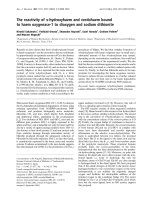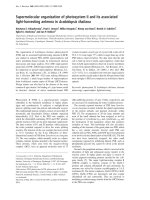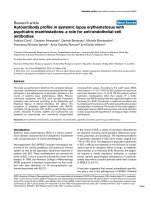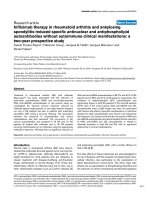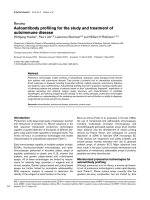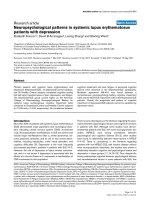Báo cáo y học: " Early atherosclerosis in systemic sclerosis and its relation to disease or traditional risk factors" pdf
Bạn đang xem bản rút gọn của tài liệu. Xem và tải ngay bản đầy đủ của tài liệu tại đây (237.29 KB, 8 trang )
Open Access
Available online />Page 49 of 56
(page number not for citation purposes)
Vol 10 No 2
Research article
Early atherosclerosis in systemic sclerosis and its relation to
disease or traditional risk factors
Martha E Hettema
1
, Dan Zhang
1
, Karina de Leeuw
1
, Ymkje Stienstra
2
, Andries J Smit
3
,
Cees GM Kallenberg
1
and Hendrika Bootsma
1
1
Department of Internal Medicine, Division of Rheumatology and Clinical Immunology, University Medical Center Groningen, University of Groningen,
Hanzeplein 1, PO Box 30.001, 9700 RB Groningen, The Netherlands
2
Department of Internal Medicine, University Medical Center Groningen, University of Groningen, Hanzeplein 1, PO Box 30.001, 9700 RB Groningen,
The Netherlands
3
Department of Internal Medicine, Division of Vascular Diseases, University Medical Center Groningen, University of Groningen, Hanzeplein 1, PO
Box 30.001, 9700 RB Groningen, The Netherlands
Corresponding author: Martha E Hettema,
Received: 13 Dec 2007 Revisions requested: 15 Jan 2008 Revisions received: 18 Mar 2008 Accepted: 25 Apr 2008 Published: 25 Apr 2008
Arthritis Research & Therapy 2008, 10:R49 (doi:10.1186/ar2408)
This article is online at: />© 2008 Hettema et al.; licensee BioMed Central Ltd.
This is an open access article distributed under the terms of the Creative Commons Attribution License ( />),
which permits unrestricted use, distribution, and reproduction in any medium, provided the original work is properly cited.
Abstract
Introduction Several systemic autoimmune diseases are
associated with an increased prevalence of atherosclerosis
which could not be explained by traditional risk factors alone. In
systemic sclerosis (SSc), microvascular abnormalities are well
recognized. Previous studies have suggested an increased
prevalence of macrovascular disease as well. We compared
patients with SSc to healthy controls for signs of early
atherosclerosis by measuring intima-media thickness (IMT) of
the common carotid artery in relation to traditional risk factors
and markers of endothelial activation.
Methods Forty-nine patients with SSc, of whom 92% had
limited cutaneous SSc, and 32 healthy controls were studied.
Common carotid IMT was measured by using B-mode
ultrasound. Traditional risk factors for cardiovascular disease
were assessed and serum markers for endothelial activation
were measured.
Results In patients with SSc, the mean IMT (median 0.69 mm,
interquartile range [IQR] 0.62 to 0.79 mm) was not significantly
increased compared with healthy controls (0.68 mm, IQR 0.56
to 0.75 mm; P = 0.067). Also, after correction for the
confounders age, high-density lipoprotein (HDL) cholesterol,
and low-density lipoprotein cholesterol (P = 0.328) or using a
different model taking into account the confounders age, HDL
cholesterol, and history of macrovascular disease (P = 0.474),
no difference in IMT was present between SSc patients and
healthy controls. Plaques were found in three patients and not in
healthy controls (P = 0.274). In patients, no correlations were
found between maximum IMT, disease-related variables, and
markers of endothelial activation. Endothelial activation markers
were not increased in SSc patients compared with controls.
Conclusion SSc is not associated with an increased prevalence
of early signs of atherosclerosis.
Introduction
Systemic sclerosis (SSc) is a generalized connective tissue
disorder characterized by fibrosis of the skin and internal
organs and widespread vascular lesions. The pathogenesis of
the vasculopathy is not fully understood, but a viral trigger,
immune reactions to viral or environmental factors, reperfusion
injury, or antiendothelial antibodies may all be involved [1].
Also, angiogenesis is insufficient or defective [2,3]. Most
attention has been given to microvascular disease in SSc, but
previous studies have suggested an increased prevalence of
macrovascular disease as well [4,5].
In other autoimmune diseases, such as systemic lupus ery-
thematosus (SLE), rheumatoid arthritis, and Wegener granulo-
matosis, a significantly increased prevalence of
atherosclerosis has been described [6-10]. Atherosclerosis
BMI = body mass index; CCA = common carotid artery; CRP = C-reactive protein; CVD = cardiovascular disease; dcSSc = diffuse cutaneous sys-
temic sclerosis; EScSG = European Scleroderma Study Group; ESR = erythrocyte sedimentation rate; HDL = high-density lipoprotein; ICA = internal
carotid artery; IMT = intima-media thickness; IQR = interquartile range; lcSSc = limited cutaneous systemic sclerosis; LDL = low-density lipoprotein;
SLE = systemic lupus erythematosus; SSc = systemic sclerosis; TM = thrombomodulin; VCAM-1 = vascular cell adhesion molecule-1; vWF = von
Willebrand factor.
Arthritis Research & Therapy Vol 10 No 2 Hettema et al.
Page 50 of 56
(page number not for citation purposes)
nowadays is considered an inflammatory disease in which
endothelial cell dysfunction is strongly implicated in its patho-
genesis [11], in part related to traditional risk factors like smok-
ing and dyslipidemia. Because of the increased cardiovascular
morbidity and mortality in the aforementioned autoimmune dis-
eases, attention has been given to the presence and treatment
of cardiovascular risk factors. Despite increased mortality
rates in SSc (partly due to cardiac involvement), cardiovascu-
lar risk factors and the presence of macrovascular disease
have been emphasized less [12,13]. In this study, we
assessed signs of early atherosclerosis by measuring intima-
media thickness (IMT) of the common carotid artery (CCA) in
patients with SSc and healthy controls. In addition, we related
the outcome to traditional risk factors and markers of endothe-
lial activation.
Materials and methods
Patients
Consecutive patients with SSc, according to the American
College of Rheumatology criteria [14], attending our outpa-
tient clinic were included. Patients were subclassified in sub-
sets as defined by LeRoy and colleagues [15,16]. Forty-nine
patients were included. Pregnancy was an exclusion criterion.
Healthy subjects were included in this study as controls. Ethi-
cal approval for the study was obtained from the Medical Eth-
ical Committee of the University Medical Center Groningen
(University of Groningen, Groningen, The Netherlands).
Informed consent was obtained from each participant.
Data were obtained from all subjects with respect to traditional
risk factors for cardiovascular disease (CVD), including body
mass index (BMI), smoking status, diabetes, blood pressure,
lipid levels, and family history of CVD (considered positive if
first-degree relatives suffered from CVD before 60 years of
age).
In patients with SSc, we assessed disease-related factors as
possible determinants of macrovascular disease. To assess
disease activity, the preliminary European Scleroderma Study
Group (EScSG) activity index (a score ranging from 0 to 10)
was used. A score higher than 3 denotes active disease
[17,18]. Also, the revised preliminary SSc severity scale
(Medsger severity scale), a measure of activity, damage, and
severity, was used. This scale is a nine-organ disease severity
scale in which for each organ system a score of 0 to 4 is
applied, with 0 being normal and 4 denoting end-stage organ
involvement [19]. We also recorded statin use, cumulative
prednisolone dose, and current or former use of immunosup-
pressive agents.
Measurements of intima-media thickness
B-mode ultrasonography was used to measure the common
carotid IMT. Measurements were limited to the CCA and not
extended to other segments. The prevalence of increased IMT
and/or plaques is substantially higher in the carotid bulb or
internal carotid artery (ICA), but the intended quantitative com-
parison between SSc patients and controls may be hindered
by including these segments. An Acuson 128XP ultrasound
device with a 7 MHz linear array transducer (Acuson Corpora-
tion, now part of Siemens Medical Solutions USA, Inc., Mal-
vern, PA, USA) was used for measuring IMT in all patients and
controls, as described before [7,20]. With the subjects in the
supine position, the left CCA wall segment was scanned from
a lateral transducer position and recorded on s-VHS tape. The
CCA wall segment was defined as 1 cm proximal to the
carotid bifurcation. The far wall of the left common artery was
assessed at three different positions. Off-line video analysis,
using a previously described image analysis program [21],
was performed by one reader unaware of patient or control
group data or characteristics. The highest IMT value found in
this segment was considered to be the maximum IMT, and the
mean of three measurements in this segment was considered
to be the mean IMT.
Blood analysis
Lipid levels were measured by routine techniques. Additional
serum and plasma samples for determination of markers of
endothelial activation were stored at -20°C until analysis.
Serum levels of vascular cell adhesion molecule-1 (s-VCAM-1)
(R&D Systems Europe Ltd, Abingdon, UK) and thrombomod-
ulin (TM) (Diaclone, Besançon, France) were measured
according to the manufacturers' instructions. Serum was used
to determine C-reactive protein (CRP) and plasma was used
to determine von Willebrand factor (vWF) using in-house
enzyme-linked immunosorbent assays, as described before
[7].
Statistical analysis
Values are expressed as mean ± standard deviation when var-
iables were normally distributed and as median with interquar-
tile range (IQR) (25th to 75th percentile) in case of a non-
normal distribution. Because the number of patients with dif-
fuse cutaneous SSc (dSSc) was low in our patient group, sub-
set analysis could not be performed. Differences between
patients and controls were assessed by Student t test, Mann-
Whitney U test, and χ
2
test (Pearson chi-square or Fisher
exact test) as appropriate. Linear regression was used to
assess the relationship between IMT and the different groups
(SSc patients and healthy controls). An unadjusted analysis in
which no corrections were made for possible confounders and
an adjusted analysis in which corrections were made for pos-
sible confounders are presented. The variables were entered
manually. The level of significance for the association between
group and outcome variable was set at a P value of less than
0.05. The variables age, gender, BMI, and smoking were also
studied as potential effect modifiers in the relationship of inter-
est. The correlation between maximum IMT and disease-
related factors and endothelial markers was assessed by
Spearman rank correlation coefficient since maximum IMT was
non-normally distributed. All analyses were carried out with the
Available online />Page 51 of 56
(page number not for citation purposes)
Statistical Package of Social Science, version 12.1. for Win-
dows (SPSS Inc., Chicago, IL, USA).
Results
Characteristics of patients and controls
The demographic characteristics and the traditional risk fac-
tors of SSc patients and healthy controls are shown in Table
1. Patients tended to be older (55.4 ± 11.6 versus 50.9 ±
10.1 years; P = 0.078) and used significantly more statins
(14% versus 0%; P = 0.038) than healthy controls. Patients
had lower levels of high-density lipoprotein (HDL) cholesterol
(1.40 mmol/L, IQR 1.23 to 1.80 mmol/L, versus 1.68 mmol/L,
IQR 1.48 to 1.89 mmol/L; P = 0.027) and higher levels of trig-
lycerides (1.36 mmol/L, IQR 1.16 to 2.14 mmol/L, versus 1.17
mmol/L, IQR 0.77 to 1.67 mmol/L; P = 0.030) than controls.
No significant differences were found in other cardiovascular
risk factors. Four patients had a history of macrovascular
events compared with none in the control group.
Patients with SSc had a median disease duration of 6 years
and had experienced Raynaud phenomenon for almost 11
years. Limited cutaneous SSc (lcSSc) was present in 92% of
patients and diffuse cutaneous SSc was present in 8% of
patients. Patients had a median modified Rodnan skin score of
7.0 (IQR 4.5 to 14.0), a preliminary EScSG disease activity
index of 0.5 (IQR 0.5 to 1.75), and a revised preliminary SSc
severity scale score (Medsger severity scale score) of 6.0
(IQR 4.5 to 7.0). The preliminary EScSG disease activity index
Table 1
Traditional risk factors in systemic sclerosis patients and healthy controls
Characteristic Patients (n = 49) Controls (n = 32) P value
Age, years 55.4 ± 11.6 50.9 ± 10.1 0.078
Male gender, number (percentage) 8 (16%) 3 (9.4%) 0.513
Body mass index, kg/m
2
23.7 ± 2.9 24.0 ± 2.9 0.582
Smoking
Pack years for smokers, number (percentage) 3 (6%) 2 (6.5%) 1.000
Median (range) 20 (1–48) 10 (6–14)
Diabetes mellitus, number (percentage) 2 (4%) 0 0.523
Hypertension treated with antihypertensive agents, number (percentage) 12 (24%) 2 (6%) 0.120
Blood pressure, mm Hg
Systolic 120 (110–135) 120 (110–125) 0.409
Diastolic 75 (70–80) 75 (70–80) 0.379
Cholesterol, mmol/L
Total 5.22 ± 1.00 5.53 ± 1.06 0.217
Low-density lipoprotein 3.02 ± 0.85 3.06 ± 1.08 0.871
High-density lipoprotein 1.40 (1.23–1.80) 1.68 (1.48–1.89) 0.027
Triglycerides, mmol/L 1.36 (1.16–2.14) 1.17 (0.77–1.67) 0.030
Lipid-lowering drugs, number (percentage) 7 (14%) 0 0.038
Simvastatin, number (mean dose in milligrams) 4 (20) 0
Atorvastatin, number (mean dose in milligrams) 2 (25) 0
Rosuvastatin, number (mean dose in milligrams) 1 (10) 0
Family history of cardiovascular disease, number (percentage) 10 (20%) 5 (16%) 0.603
Cardiovascular history, number (percentage) 4 (8%) 0 0.149
Cardiovascular 1
Cerebrovascular 1
Peripheral vascular disease 2
C-reactive protein, mg/L 3.5 (1.6–7.0) 0.8 (0.3–2.0) < 0.001
Unless stated otherwise, data are expressed as mean ± standard deviation when normally distributed and as median (interquartile range) when
non-normally distributed.
Arthritis Research & Therapy Vol 10 No 2 Hettema et al.
Page 52 of 56
(page number not for citation purposes)
may have been an underestimation of reality since not all
variables (especially erythrocyte sedimentation rate [ESR] and
complement) were available. As shown in Table 1, CRP levels
were not substantially elevated, suggesting normal ESR levels.
However, patients had significantly higher CRP levels than
controls (3.5, IQR 1.6 to 7.0, versus 0.8, IQR 0.3 to 2.0; P <
0.001). Forty-three percent of patients were current or former
users of prednisolone, with a median cumulative dose of 3.6 g
(1.9 to 16.1 g) (Table 2).
Intima-media thickness
The median values for the mean IMT measurements in the
CCA were 0.69 mm (IQR 0.62 to 0.79 mm) in patients and
0.68 mm (IQR 0.56 to 0.75 mm) in controls (Figure 1a). Also,
IMT values were comparable between SSc patients and con-
trols for each age decade. Among the four outliers in the group
of SSc patients with an IMT of greater than 1.10 mm, one
patient had a history of a cerebrovascular accident and one
patient was known to have left ventricular dysfunction proba-
bly caused by coronary artery disease. Both had other cardio-
vascular risk factors like current or former smoking and
hypertension. The other two patients were not known to have
clinically manifest CVDs. One of these patients had a family
history of CVD. Other risk factors were not present. Although
plaques were not a primary endpoint, they were observed in
three patients and not in healthy controls. Linear regression
analysis of the mean IMT in the CCA between controls and
patients, when not corrected for possible confounders, dem-
onstrated no significant difference in mean IMT (B = 0.101; P
= 0.067) (Table 3). Also, no significant differences were seen
between the groups after correction for the strongest con-
founders. Both in the model with the confounders age, HDL
cholesterol, and low-density lipoprotein (LDL) cholesterol (B =
0.042; P = 0.328) and in the model with the confounders age,
HDL cholesterol, and history of macrovascular disease (B =
0.030; P = 0.474), no differences were found between
patients and healthy controls. The possible relationship
between mean IMT and SSc patients versus controls was lost
when traditional risk factors were entered into the regression
analysis. The addition of the confounder history of hyperten-
sion did not change the outcome. No correction for systolic
and diastolic blood pressure, use of statins, smoking, diabetes
mellitus, gender, BMI, total cholesterol, or triglycerides was
necessary since these outcome parameters were not con-
founders in the linear regression model. No effect modification
by age, gender, BMI, or smoking was found.
No significant differences were seen for the maximum IMT of
the CCA between SSc patients (0.83 mm, IQR 0.70 to 0.97
mm) and healthy controls (0.77 mm, IQR 0.70 to 0.88 mm) by
means of linear regression analysis before or after correction
for the confounders age, HDL cholesterol, gender, and history
of macrovascular disease (Figure 1b and Table 4). The addi-
tion of the other confounders (that is, history of hypertension,
diastolic blood pressure, and LDL cholesterol) did not change
Table 2
Characteristics of patients with systemic sclerosis
Disease characteristic N = 49
Systemic sclerosis subset, number (percentage)
Diffuse cutaneous systemic sclerosis 4 (8%)
Limited cutaneous systemic sclerosis 45 (92%)
Disease duration, years 6 (2–12)
Raynaud phenomenon duration, years 11 (6–25)
Antibody, number (percentage)
Scl70 (topoisomerase 1) 4 (8%)
Centromere 22 (45%)
Nuclear ribonucleoprotein 2 (4%)
Antinuclear antibodies, not specified 17 (35%)
None 4 (8%)
EScSG disease activity index 0.5 (0.5–1.5)
Medsger severity scale score 6.0 (4.5–7.0)
Modified Rodnan skin score 7.0 (4.5–14.0)
Prednisolone use, number (percentage)
None 28 (57%)
Former 13 (27%)
Current 8 (16%)
Cumulative prednisolone dose, grams 3.6 (1.9–16.1)
Immunosuppressive agents, number (percentage)
Never used 25 (51%)
Former or current users 24 (49%)
Methotrexate
Current 12
Former 7
Cyclophosphamide
Current 2
Former 4
Azathioprine
Current 3
Former 3
Cyclosporin
Current 0
Former 1
Unless stated otherwise, data are expressed as mean ± standard
deviation when normally distributed and as median (interquartile
range) when non-normally distributed. EScSG, European
Scleroderma Study Group.
Available online />Page 53 of 56
(page number not for citation purposes)
the outcome. In patients, no correlations were found between
maximum IMT, CRP, and disease-related variables.
Endothelial activation markers
Markers of endothelial activation were not increased in
patients with SSc. Compared with controls, levels of VCAM-1
were even decreased (229 ng/mL, IQR 188 to 311 ng/mL,
versus 287 ng/mL, IQR 236 to 350 ng/mL; P = 0.014). No dif-
ferences between SSc patients and controls were found in
levels of vWF (72%, IQR 34% to 125%, versus 71%, IQR
48% to 110%; P = 0.691) and TM (3.8 ng/mL, IQR 2.3 to 5.0
ng/mL, versus 2.9 ng/mL, IQR 2.1 to 3.7 ng/mL; P = 0.151)
(Figure 2). Levels of endothelial markers were not correlated
with maximum IMT.
Discussion
This study did not show differences in the IMT of the CCA and
prevalence of plaques between patients with SSc and healthy
controls, suggesting no increased prevalence of early athero-
sclerotic macrovascular disease in SSc. Also, no correlations
were found between IMT, disease-related factors, and markers
of endothelial activation. Traditional risk factors, like increasing
age and dyslipidemia, accounted for increased IMT values in
SSc patients and controls.
After the first reports suggesting an increased prevalence of
macrovascular involvement in SSc, several studies have been
performed in the last decade using IMT of the carotid artery as
a marker of early atherosclerosis. Lekakis and colleagues [22],
Kaloudi and colleagues [23], and Bartoli and colleagues
[24,25] found strongly increased IMT values in the CCA in
SSc patients compared with controls. In these studies, mean
IMT values were markedly higher than in our patients whereas
mean age was comparable. It is not known whether patient
groups in studies by Kaloudi and colleagues [23] and Bartoli
and colleagues [24,25] are from overlapping cohorts since
these studies were performed in the same center and pub-
lished in the same period. A larger percentage of diffuse cuta-
neous systemic sclerosis (dcSSc) subtype was present in
these studies compared with our study, although Kaloudi and
colleagues [23] found no significant differences between
mean IMT between subtypes. On the other hand, our results
are in agreement with those of Cheng and colleagues [26,27]
and Szucs and colleagues [28], who found no differences in
IMT values in SSc patients compared with controls. Apart from
a younger age and a larger percentage of dcSSc subtype in
the study by Cheng and colleagues [27], age was compara-
ble, as were IMT values. No difference was present in IMT val-
ues between subsets in this study either [26]. In view of this
Table 3
Linear regression analysis for risk factors for mean intima-media thickness of the left common carotid artery in systemic sclerosis
patients and healthy controls
Group (controls, patients) B
a
95% confidence interval P value
Unadjusted/crude 0.101 -0.007, 0.209 0.067
Adjusted
b
0.042 -0.043, 0.128 0.328
Adjusted
c
0.030 -0.054, 0.114 0.474
a
B is the regression coefficient. In the adjusted models, corrections were made for the confounders
b
age, high-density lipoprotein (HDL)
cholesterol, and low-density lipoprotein cholesterol or
c
age, HDL cholesterol, and history of macrovascular disease; a total of 66 patients and
controls were available for this analysis.
Figure 1
Box plots of (a) mean and (b) maximum left common carotid artery (CCA) intima-media thickness (IMT) of systemic sclerosis (SSc) patients and healthy controlsBox plots of (a) mean and (b) maximum left common carotid artery (CCA) intima-media thickness (IMT) of systemic sclerosis (SSc) patients and
healthy controls. Data are uncorrected for confounders. The median, interquartile range, and minimum and maximum values are shown.
Arthritis Research & Therapy Vol 10 No 2 Hettema et al.
Page 54 of 56
(page number not for citation purposes)
findings and given the small number of patients with dcSSc in
our study, we did not perform a subset analysis. Overall, these
discrepancies between studies in the presence of early
atherosclerosis as measured by common carotid IMT in SSc
patients might be explained by methodological differences,
such as patients included in the study and comorbidity.
In our SSc patients, lipid levels and statin use were statistically
different from healthy controls. After correction for the strong-
est confounders in our model, no differences were seen in IMT
values between SSc patients and healthy controls. Although
statin use was no confounder in our model, a meta-analysis
showed that statin therapy is efficient in decreasing the rate of
carotid atherosclerosis progression in the long term [29]. Oth-
erwise, statins may have a potential benefit in preventing
endothelial dysfunction in SSc patients [30].
Treatment with immunosuppressive agents, especially corti-
costeroids, influences the atherogenic process. Corticoster-
oids are considered to have atherogenic properties [31], like
azathioprine [32], whereas for hydroxychloroquine [31] and
methotrexate [9], a protective effect against atherosclerosis
has been described. Otherwise, immunosuppressive therapy
with prednisolone, cyclophosphamide, or hydroxychloquine
was associated with the absence of plaques in patients with
SLE [33]. It is difficult to establish whether the observed asso-
ciations between immunosuppressive agents and atheroscle-
rosis are due to the immunosuppressive agents themselves or
to their effect on the activity of the autoimmune disease. In our
study, 49% were former or current users of immunosuppres-
sive agents. No association was found between maximum IMT
and cumulative prednisolone dose and use of other immuno-
suppressive agents.
Markers of inflammation, such as CRP, are related to the risk
of cardiovascular and peripheral vascular disease. Increased
levels of CRP are associated with increased risk of sympto-
matic disease [34,35]. In our population, CRP levels were sig-
nificantly elevated compared with healthy controls. The CRP
levels we found might have been associated with future coro-
nary events [34,35], but we found no association between
CRP and IMT values. This can be explained by the study
design. Our study was not designed to find a relationship
between CRP and risk of CVD, and we did not exclude other
conditions that could explain elevated CRP levels, like intercur-
rent infections. Otherwise, in SSc patients, besides elevations
due to infection, no significant elevations of CRP levels are
seen [36].
Surprisingly, we did not find elevated levels of endothelial acti-
vation markers. Our population of SSc patients was heteroge-
neous with respect to disease duration. The typical patient had
inactive disease. Most inflammation is expected in the early
stages of the disease or in patients with active disease. Also,
by using the Medsger severity scale, we could not find an
association between macrovascular disease and the severity
of SSc. This might explain the absence of increased levels of
endothelial activation markers. All these data point to the
absence of premature atherosclerosis in SSc.
Our results might be an underestimation of atherosclerosis in
SSc patients and controls. Besides the possible explanations
as stated above, our patients were suffering predominantly
from lcSSc, in which inflammation is not always present [37].
However, when IMT values were analyzed in subsets, other
authors did not find differences in these values between sub-
sets [23,26]. Furthermore, we used IMT values of the CCA.
Table 4
Linear regression analysis unadjusted and adjusted for risk factors for maximum intima-media thickness of the left common carotid
artery in systemic sclerosis patients and healthy controls
Group (controls, patients) B
a
95% confidence interval P value
Unadjusted/crude 0.101 -0.017, 0.219 0.093
Adjusted
b
0.028 -0.071, 0.127 0.577
Adjusted
c
0.022 -0.081, 0.126 0.668
a
B is the regression coefficient. In the adjusted models, corrections were made for the confounders
b
age, high-density lipoprotein (HDL)
cholesterol, and gender or
c
age, HDL cholesterol, and history of macrovascular disease; a total of 66 patients and controls were available for this
analysis.
Figure 2
Endothelial activation markersEndothelial activation markers. Boxes indicate the median value and the
interquartile ranges. Lines indicate the minimum and maximum values.
Dotted bars represent systemic sclerosis patients and open bars repre-
sent controls. TM, thrombomodulin; VCAM-1, vascular cell adhesion
molecule-1; vWF, von Willebrand factor. **P < 0.05.
Available online />Page 55 of 56
(page number not for citation purposes)
This segment is commonly evaluated in our laboratory as it can
be approached easily and measurements on this segment are
reproducible. Using the same protocol as described here, we
found increased IMT values in patients with SLE [38]. How-
ever, atherosclerotic lesions appear later in the CCA than in
the ICA or bulb, but these latter two segments are more diffi-
cult to visualize [39]. Also, it can be difficult to assess whether
IMT of the CCA represents atherosclerosis or vascular hyper-
trophy [40]. Although other noninvasive markers of early
changes in the arterial wall are available (such as arterial wall
thickening and stiffening), carotid IMT has been used more fre-
quently and has been found to be a strong predictor of future
vascular events [40,41].
Conclusion
IMT of the CCA is not increased in patients with SSc com-
pared with controls, either when uncorrected or corrected for
traditional risk factors. So, SSc seems not to be associated
with increased early atherosclerotic macrovascular disease. It
seems that, although SSc is characterized by endothelial dys-
function, this is reflected mainly in microvascular disease.
Competing interests
The authors declare that they have no competing interests.
Authors' contributions
MEH participated in the conception and design of the study,
participated in the recruitment of patients and controls and
data collection, helped to conduct the statistical analysis, and
was involved in drafting the manuscript or revising it critically.
KdL participated in the conception and design of the study,
participated in the recruitment of patients and controls and
data collection, helped to perform enzyme-linked immunosorb-
ent assay (ELISA) experiments, and was involved in drafting
the manuscript or revising it critically. AJS, CGMK, and HB
participated in the conception and design of the study and
were involved in drafting the manuscript or revising it critically.
DZ participated in the recruitment of patients and controls and
data collection and helped to perform ELISA experiments. YS
helped to conduct the statistical analysis. All authors read and
approved the final manuscript.
References
1. Kahaleh MB, LeRoy EC: Autoimmunity and vascular involve-
ment in systemic sclerosis (SSc). Autoimmunity 1999,
31:195-214.
2. LeRoy EC: Systemic sclerosis. A vascular perspective. Rheum
Dis Clin North Am 1996, 22:675-694.
3. Mackiewicz Z, Sukura A, Povilenaité D, Ceponis A, Virtanen I,
Hukkanen M, Konttinen YT: Increased but imbalanced expres-
sion of VEGF and its receptors has no positive effect on ang-
iogenesis in systemic sclerosis skin. Clin Exp Rheumatol 2002,
20:641-646.
4. Ho ML, Veale D, Eastmond C, Nuki G, Belch J: Macrovascular
disease and systemic sclerosis. Ann Rheum Dis 2000,
59:39-43.
5. Veale DJ, Collidge TA, Belch JJF: Increased prevalence of symp-
tomatic macrovascular disease in systemic-sclerosis. Ann
Rheum Dis 1995, 54:853-855.
6. Alkaabi JK, Ho M, Levison R, Pullar T, Belch JJF: Rheumatoid
arthritis and macrovascular disease. Rheumatology 2003,
42:292-297.
7. De Leeuw K, Sanders JS, Stegeman C, Smit A, Kallenberg CG, Bijl
M: Accelerated atherosclerosis in patients with Wegener's
granulomatosis. Ann Rheum Dis 2005, 64:753-759.
8. Esdaile JM, Abrahamowicz M, Grodzicky T, Li Y, Panaritis C, du
Berger R, Côte R, Grover SA, Fortin PR, Clarke AE, Senécal JL:
Traditional Framingham risk factors fail to fully account for
accelerated atherosclerosis in systemic lupus erythematosus.
Arthritis Rheum 2001, 44:2331-2337.
9. Wallberg-Jonsson S, Ohman M, Rantapaa-Dahlqvist S: Which fac-
tors are related to the presence of atherosclerosis in rheuma-
toid arthritis? Scand J Rheumatol 2004, 33:373-379.
10. Shoenfeld Y, Gerli R, Doria A, Matsuura E, Cerinic MM, Ronda N,
Jara LJ, Abu-Shakra M, Meroni PL, Sherer Y: Accelerated athero-
sclerosis in autoimmune rheumatic diseases. Circulation
2005, 112:3337-3347.
11. Ross R: Atherosclerosis – An inflammatory disease. N Engl J
Med 1999, 340:115-126.
12. Mayes MD, Lacey JV Jr, Beebe-Dimmer J, Gillespie BW, Cooper
B, Laing TJ, Schottenfeld D: Prevalence, incidence, survival, and
disease characteristics of systemic sclerosis in a large US
population.
Arthritis Rheum 2003, 48:2246-2255.
13. Ioannidis JP, Vlachoyiannopoulos PG, Haidich AB, Medsger TA Jr,
Lucas M, Michet CJ, Kuwana M, Yasuoka H, Hoogen F van den, Te
Boome L, van Laar JM, Verbeet NL, Matucci-Cerinic M, Georgount-
zos A, Moutsopoulos HM: Mortality in systemic sclerosis: an
international meta-analysis of individual patient data. Am J
Med 2005, 118:2-10.
14. Subcommittee for Scleroderma Criteria of the American Rheuma-
tism Association Diagnostic and Therapeutic Criteria Committee:
Preliminary criteria for the classification of systemic-sclerosis
(scleroderma). Arthritis Rheum 1980, 23:581-590.
15. LeRoy EC, Black C, Fleischmajer R, Jablonska S, Krieg T, Medsger
TA Jr, Rowell N, Wollheim F: Scleroderma (systemic-sclerosis)
– classification, subsets and pathogenesis. J Rheumatol 1988,
15:202-205.
16. LeRoy EC, Medsger TA Jr: Criteria for the classification of early
systemic sclerosis. J Rheumatol 2001, 28:1573-1576.
17. Valentini G, Della Rossa A, Bombardieri S, Bencivelli W, Silman
AJ, D'Angelo S, Cerinic MM, Belch JF, Black CM, Bruhlmann P,
Czirják L, De Luca A, Drosos AA, Ferri C, Gabrielli A, Giacomelli R,
Hayem G, Inanc M, McHugh NJ, Nielsen H, Rosada M, Scorza R,
Stork J, Sysa A, Hoogen FH van den, Vlachoyiannopoulos PJ:
European multicentre study to define disease activity criteria
for systemic sclerosis. II. Identification of disease activity vari-
ables and development of preliminary activity indexes. Ann
Rheum Dis 2001, 60:592-598.
18. Valentini G, Bencivelli W, Bombardieri S, D'Angelo S, Della Rossa
A, Silman AJ, Black CM, Czirjak L, Nielsen H, Vlachoyiannopoulos
PG: European Scleroderma Study Group to define disease
activity criteria for systemic sclerosis. III. Assessment of the
construct validity of the preliminary activity criteria. Ann
Rheum Dis 2003, 62:901-903.
19. Medsger TA, Bombardieri S, Czirjak L, Scorza R, Della Rossa A,
Bencivelli W: Assessment of disease severity and prognosis.
Clin Exp Rheumatol 2003, 21:S42-S46.
20. Blaauw J, van Pampus MG, van Doormaal JJ, Fokkema MR, Fidler
V, Smit AJ, Aarnoudse JG: Increased intima-media thickness
after early-onset preeclampsia. Obstet Gynecol 2006,
107:1345-1351.
21. Selzer RH, Hodis HN, Kwong-Fu H, Mack WJ, Lee PL, Liu CR, Liu
CH: Evaluation of computerized edge tracking for quantifying
intima-media thickness of the common carotid artery from B-
mode ultrasound images. Atherosclerosis 1994, 111:
1-11.
22. Lekakis J, Mavrikakis M, Papamichael C, Papazoglou S, Economou
O, Scotiniotis I, Stamatelopoulos K, Vemmos C, Stamatelopoulos
S, Moulopoulos S: Short-term estrogen administration
improves abnormal endothelial function in women with sys-
temic sclerosis and Raynaud's phenomenon. Am Heart J 1998,
136:905-912.
23. Kaloudi O, Basta G, Perfetto F, Bartoli F, Del Rosso A, Miniati I,
Conforti ML, Generini S, Guiducci S, Abbate R, Pignone A, Cas-
tellani S, Livi R, De Caterina R, Matucci-Cerinic M: Circulating lev-
els of Nepsilon-(carboxymethyl)lysine are increased in
systemic sclerosis. Rheumatology (Oxford) 2007, 46:412-416.
Arthritis Research & Therapy Vol 10 No 2 Hettema et al.
Page 56 of 56
(page number not for citation purposes)
24. Bartoli F, Angotti C, Fatini C, Conforti ML, Guiducci S, Blagojevic
J, Melchiorre D, Fiori G, Generini S, Damjanov N, Rednic S,
Pignone A, Castellani S, Abbate R, Matucci Cerinic M: Angi-
otensin-converting enzyme I/D polymorphism and macrovas-
cular disease in systemic sclerosis. Rheumatology (Oxford)
2007, 46:772-775.
25. Bartoli F, Blagojevic J, Bacci M, Fiori G, Tempestini A, Conforti ML,
Guiducci S, Miniati I, Di Chicco M, Del Rosso A, Perfetto F, Cas-
tellani S, Pignone A, Cerinic MM: Flow-mediated vasodilation
and carotid intima-media thickness in systemic sclerosis. Ann
N Y Acad Sci 2007, 1108:283-290.
26. Cheng KS, Tiwari A, Boutin A, Denton CP, Black CM, Morris R,
Hamilton G, Seifalian AM: Carotid and femoral arterial wall
mechanics in scleroderma. Rheumatology (Oxford) 2003,
42:1299-1305.
27. Cheng KS, Tiwari A, Boutin A, Denton CP, Black CM, Morris R,
Seifalian AM, Hamilton G: Differentiation of primary and sec-
ondary Raynaud's disease by carotid arterial stiffness. Eur J
Vasc Endovasc Surg 2003, 25:336-341.
28. Szucs G, Tímár O, Szekanecz Z, Dér H, Kerekes G, Szamosi S,
Shoenfeld Y, Szegedi G, Soltész P: Endothelial dysfunction pre-
cedes atherosclerosis in systemic sclerosis. Relevance for
prevention of vascular complications. Rheumatology (Oxford)
2007, 46:759-762.
29. Kang S, Wu Y, Li X: Effects of statin therapy on the progression
of carotid atherosclerosis: a systematic review and meta-anal-
ysis. Atherosclerosis 2004, 177:433-442.
30. Kuwana M: Potential benefit of statins for vascular disease in
systemic sclerosis. Curr Opin Rheumatol 2006, 18:594-600.
31. Petri M, Lakatta C, Magder L, Goldman D: Effect of prednisone
and hydroxychloroquine on coronary artery disease risk fac-
tors in systemic lupus erythematosus: a longitudinal data
analysis. Am J Med 1994, 96:254-259.
32. Doria A, Shoenfeld Y, Wu R, Gambari PF, Puato M, Ghirardello A,
Gilburd B, Corbanese S, Patnaik M, Zampieri S, Peter JB,
Favaretto E, Iaccarino L, Sherer Y, Todesco S, Pauletto P: Risk
factors for subclinical atherosclerosis in a prospective cohort
of patients with systemic lupus erythematosus. Ann Rheum
Dis 2003, 62:1071-1077.
33. Roman MJ, Shanker B, Davis A, Lockshin MD, Sammaritano L,
Simantov R, Crow MK, Schwartz JE, Paget SA, Devereux RB,
Salmon JE: Prevalence and correlates of accelerated athero-
sclerosis in systemic lupus erythematosus.
N Engl J Med
2003, 349:2399-2406.
34. Folsom AR, Aleksic N, Catellier D, Juneja HS, Wu KK: C-reactive
protein and incident coronary heart disease in the Atheroscle-
rosis Risk In Communities (ARIC) study. Am Heart J 2002,
144:233-238.
35. Ridker PM, Cushman M, Stampfer MJ, Tracy RP, Hennekens CH:
Plasma concentration of C-reactive protein and risk of devel-
oping peripheral vascular disease. Circulation 1998,
97:425-428.
36. Kucharz EJ, Grucka-Mamczar E, Mamczar A, Brzezinska-Wcislo L:
Acute-phase proteins in patients with systemic sclerosis. Clin
Rheumatol 2000, 19:165-166.
37. Valentini G, Silman AJ, Veale D: Assessment of disease activity.
Clin Exp Rheumatol 2003, 21:S39-S41.
38. De Leeuw K, Freire B, Smit AJ, Bootsma H, Kallenberg CG, Bijl M:
Traditional and non-traditional risk factors contribute to the
development of accelerated atherosclerosis in patients with
systemic lupus erythematosus. Lupus 2006, 15:675-682.
39. Poredos P: Intima-media thickness: indicator of cardiovascular
risk and measure of the extent of atherosclerosis. Vasc Med
2004, 9:46-54.
40. Simon A, Gariepy J, Chironi G, Megnien JL, Levenson J: Intima-
media thickness: a new tool for diagnosis and treatment of
cardiovascular risk. J Hypertens 2002, 20:159-169.
41. Lorenz MW, Markus HS, Bots ML, Rosvall M, Sitzer M: Prediction
of clinical cardiovascular events with carotid intima-media
thickness: a systematic review and meta-analysis. Circulation
2007, 115:459-467.

